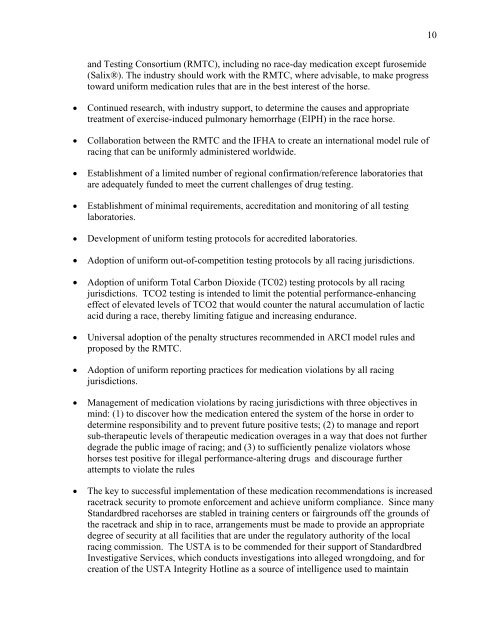Retired Racehorses
tfrr_reportandappendicesfinal
tfrr_reportandappendicesfinal
- No tags were found...
You also want an ePaper? Increase the reach of your titles
YUMPU automatically turns print PDFs into web optimized ePapers that Google loves.
10<br />
and Testing Consortium (RMTC), including no race-day medication except furosemide<br />
(Salix®). The industry should work with the RMTC, where advisable, to make progress<br />
toward uniform medication rules that are in the best interest of the horse.<br />
• Continued research, with industry support, to determine the causes and appropriate<br />
treatment of exercise-induced pulmonary hemorrhage (EIPH) in the race horse.<br />
• Collaboration between the RMTC and the IFHA to create an international model rule of<br />
racing that can be uniformly administered worldwide.<br />
• Establishment of a limited number of regional confirmation/reference laboratories that<br />
are adequately funded to meet the current challenges of drug testing.<br />
• Establishment of minimal requirements, accreditation and monitoring of all testing<br />
laboratories.<br />
• Development of uniform testing protocols for accredited laboratories.<br />
• Adoption of uniform out-of-competition testing protocols by all racing jurisdictions.<br />
• Adoption of uniform Total Carbon Dioxide (TC02) testing protocols by all racing<br />
jurisdictions. TCO2 testing is intended to limit the potential performance-enhancing<br />
effect of elevated levels of TCO2 that would counter the natural accumulation of lactic<br />
acid during a race, thereby limiting fatigue and increasing endurance.<br />
• Universal adoption of the penalty structures recommended in ARCI model rules and<br />
proposed by the RMTC.<br />
• Adoption of uniform reporting practices for medication violations by all racing<br />
jurisdictions.<br />
• Management of medication violations by racing jurisdictions with three objectives in<br />
mind: (1) to discover how the medication entered the system of the horse in order to<br />
determine responsibility and to prevent future positive tests; (2) to manage and report<br />
sub-therapeutic levels of therapeutic medication overages in a way that does not further<br />
degrade the public image of racing; and (3) to sufficiently penalize violators whose<br />
horses test positive for illegal performance-altering drugs and discourage further<br />
attempts to violate the rules<br />
• The key to successful implementation of these medication recommendations is increased<br />
racetrack security to promote enforcement and achieve uniform compliance. Since many<br />
Standardbred racehorses are stabled in training centers or fairgrounds off the grounds of<br />
the racetrack and ship in to race, arrangements must be made to provide an appropriate<br />
degree of security at all facilities that are under the regulatory authority of the local<br />
racing commission. The USTA is to be commended for their support of Standardbred<br />
Investigative Services, which conducts investigations into alleged wrongdoing, and for<br />
creation of the USTA Integrity Hotline as a source of intelligence used to maintain


